"ELVIS : ALOHA FROM HAWAII - Through The Eyes of Japan".
Fifty years after Elvis’ legendary concert in Hawaii... many valuable, long-lost negatives have been discovered - Beautiful photographs taken by Japanese cameraman, Yoshiji Kizaki.
Mr. Kizaki is one of the few photographers who photographed not only the actual show in January 1973, but also the three Aloha performances and press conference held in November of the previous year.
At last, they will be reprinted from the original negatives and finally published as a gorgeous photo-book!
We have carefully rescanned all of Kizaki's amazing photographs and selected about 300 from them.
Also includes contributions from people involved in the live satellite broadcast and record release.
Includes the treasured photos of the people involved, as well as newspaper and record company documentation from the time.
Deluxe Size 290mm x 235mm, 1.5kg, hard cover color/black & white 200 pages, text in English (translated by David Ward) |
While this exciting new book won't be published until January 2024, the cut-off date for Pre-orders with getting a free set of stunning photocards is next Monday, November 20. EIN has received a large amount of reader feedback about this release and so it seems the perfect time to ask David Ward some key questions about the book.
EIN: Hi David, thanks very much to agreeing to this interview about what looks like to be a stunning new look at Elvis' Aloha concert - especially after we so recently chatted to you about your new book about Elvis Japanese vinyl. Elvis must be keeping you busy!
David Ward: He has been keeping me busy but that’s the way I like it.
EIN: Can I first ask how long this book has been in production, how many people were involved and where were all these fantastic photographs discovered? I presume Yoshiji Kizaki is no longer alive but I can't find any information about him.
DW: I understand the project was started around a year and a half ago. With designers, editors and marketing staff, I think there are around ten people involved.
The original negatives had been lost for many years until Yoshiji Kizaki found them all last year. Yes, he’s still alive and well. Apparently, some of the negatives were scratched or suffered from colour fading and it was quite a job for staff to restore them. As well as his photography, Kizaki is also known for his work as a music critic. He started a couple of magazines in the 1960s and 1970s and wrote liner notes for many records, including Elvis’.
EIN: Were you involved in the book from the very start?
DW: No. All I did was the translation and a little proofreading. I will say that I learned a lot and came to realize how integral Japan was to the whole project.
 |
EIN: It is quite amazing that Yoshiji Kizaki managed to be at both the press conference as well as all three Hawaii concerts. Was he a member of the press or was he just a super fan?
DW: He mentions in the foreword how that happened. Let’s just say he had good connections.
By the way, the story of his Elvis autograph that he got in Hawaii is also in the book and is very funny.
EIN: I strongly suspect that a lot of fans would think that Japan and Hawaii are far closer than they are in reality. It is a seven hour flight even nowadays so it does seem a labour of love that he kept doing the trips over to see Elvis. Did he make any money from the photographs he was taking to pay for the costs?
DW: His photographs appeared in Japanese magazines at that time as well as on RCA releases so presumably he was suitably remunerated, but it’s true that trips to Hawaii weren’t cheap back then. He probably made a better living from writing about music, but I don’t know for sure.
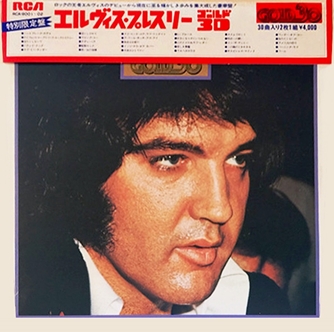 |
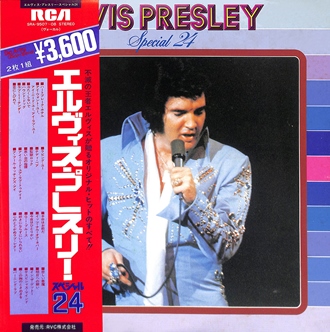 |
EIN: Kizaki's photos that fans might know from Japanese vinyl compilations such as 'GOLD 30' were far more interesting than some of those Ed Bonja photos Parker was using for RCA releases. The quality of the photographs in the previews we have seen look stunning. What were your thoughts when you first saw them?
DW: I’ve only seen a rough draft copy so far that was sent to me for proofreading, and in all honesty, I was more focussed on the words. I did, of course, glance at the photos and many were new to me. I’m really looking forward to seeing the finished product.
 |
EIN: I love the fact that this "Aloha" book contains both the November and January concerts. However I have never seen any credit for these Japanese photos in any of the official Sony releases, and by now most of the photographs in those look all-too-familiar. Do you know if anyone in the Japan Elvis Society was contacted to be involved in the Aloha recent official 50th anniversary SONY rerelease?
DW: Kizaki received credit back in the seventies on the Japanese records and in magazines, but I heard that since then he doesn’t especially like having his photos used, so if you have seen any in recent releases, the chances are he wasn’t asked for permission. He’s wanted to have them all together in one place for quite a while.
The 50th anniversary SONY rerelease was only issued as an import in Japan, so my guess is that the Japanese fan club, or the Elvis Presley Society of Japan as it’s now known, had no involvement with it. This book, in fact, was commissioned by the Society.
 |
EIN: I was pleased to note that Japan journalist Reiko Yukawa was at the press conference and had several contacts with Elvis. In the 70s, of course, most rock 'n' roll journalists would have been male so it's great that she got to ask her questions. Have you met her and does she have great stories to tell?
DW: Unfortunately, I haven’t met her, no. Probably her most famous story is getting Elvis to sign her wedding certificate. The Society is holding an event on January 8 next year to celebrate the publication of the book. I’ve been invited, so maybe I’ll get a chance to meet her then. She’s a woman of many talents and well known in Japan. She still DJs on Japanese radio even now but she’s also written lyrics and works of non-fiction. She even appeared on the US TV show, What’s My Line, many years ago. The video is on YouTube.
EIN: Similarly how fascinating that Ms Akiko Takahashi also got closely involved with RCA, managing to get the Aloha master tapes for a super-fast release in Japan. So are people wrong to imagine Japan in the seventies as a male dominated society?
DW: Back then, and even to a large extent today, women were expected to quit work and become housewives and mothers, so women with “good jobs” didn’t necessarily have long careers. Even today, most mothers returning to work after childbirth only work part-time. I live close to a kindergarten, and you almost never see a father bringing the kids or picking them up.
Akiko Takahashi must have been a remarkable woman as she was still young when she rose to head of her department. She got the first copy of the master tapes by virtue of taking the trouble to go and get one. And, as you will see, there were plenty of Japan release variations. She’s also alive and well. Do you see a pattern emerging here?
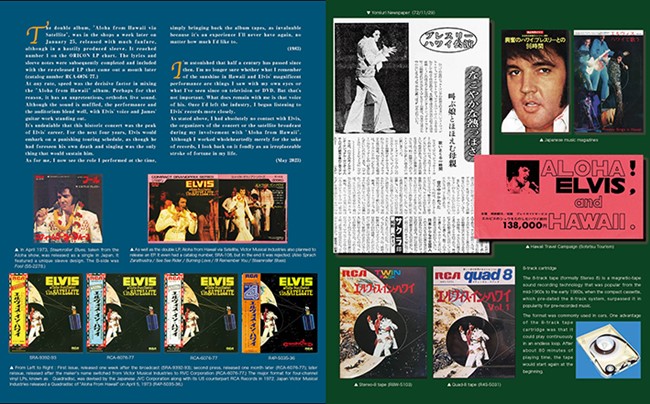 |
EIN: Another key contributor is Japanese broadcast director Shigehiro Ushikubo. He was obviously in Hawaii, so does that actually mean that there was a different Aloha satellite feed for Japan compared to the rest of the world? That would have cost extra.
DW: Shigehiro Ushikubo was in charge of the non-concert footage that was used in addition to the Elvis show. It wasn’t just a case of airing the concert and then on to the next programme. It was a big TV event in Japan.
As you know, Japan was one of only a few countries to see the concert live on TV. People in the US only got to see the show later and they didn’t always use the same camera angles. You get to see Elvis from different camera angles on the original Japanese broadcast. A rerelease of the Japanese footage – now that would have been a 50th anniversary release to get excited about. Oh. Shigehiro Ushikubo is still with us too.
EIN: Without giving too much away what was the most exciting thing you personally discovered from this publication?
DW: I think reading about each contributor’s role, which was different in each case, really brings home how hectic the Aloha schedule was. As a whole. it’s a fascinating window into what went on behind the scenes. What also comes across is how hard these people worked, to the extent that they couldn’t fully enjoy the experience of seeing Elvis in concert and, in some cases, in person. Their involvement in the project also made a lasting impression on each of them.
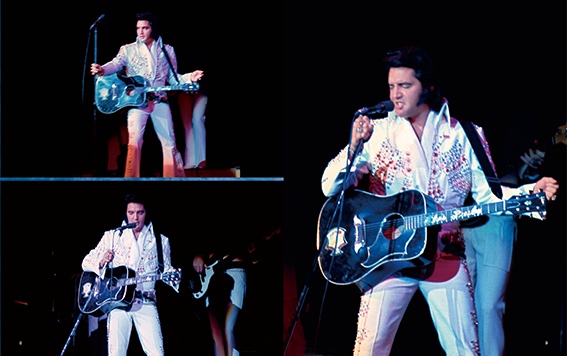 |
EIN: Col Parker has been getting much more attention since the Baz Luhrmann ELVIS movie? Are there any good stories about him in this book?
DW: Colonel Parker is all over the book. That’s to be expected, given that the text is largely about how the broadcast and album were produced. No one speaks ill of him, though, and his personality comes through even in the shortest of stories.
EIN: It will be interesting for a change to hear something less negative about the old rogue! I am personally looking forward to seeing some high quality images from Elvis' November Hawaii performances as the ones I have are rather out of focus or blurred. Do you think fans will be impressed by the quality of the photos having been rescanned from the original negatives?
DW: I believe so, given the work that’s gone into the book. I went for lunch with the editor last month and he told me that although many of Kizaki’s photos will be familiar to fans outside Japan, they’ll be surprised to see how clear they are in the book. Kizaki’s photos that appeared overseas were probably copies of Japanese publications.
 |
 |
Please note to stop others copying & pasting, EIN has kept all the sample pages deliberately low-res
EIN: As far as I know the November 1972 Hawaii performances are only available via audience recordings. In all your research have you heard anybody mention soundboards of those concerts?
DW: I haven’t, although I’m no expert on all the different concerts Elvis gave. Surely FTD would have released them if there were any soundboards.
EIN: The amount of interest we have received from EIN readers is truly impressive, especially when everybody is so accustomed to buying Elvis photo-books from Europe. Do you know if the Japanese Fanclub has been surprised by the amount of interest in the book?
DW: I imagine so as the demand from overseas fans has been five times greater than in Japan.
EIN: So far a limited print-run of 500 has been mentioned but I imagine demand is actually much higher. Will there be more copies?
DW: The first run will be 500 copies but if this interview generates enough additional interest in the book, I think the Society would consider issuing a second print. I’ve also heard that if the book sells well, they’re thinking about doing a second volume using unseen photos taken by Japanese fans who went to see Elvis in Hawaii in 1972 and 1973. Even though the exchange rate then was over twice what it is now, a lot of people from Japan flew to Hawaii to see his shows.
There must be hundreds of unpublished photos out there taken by those fans. I’m sure you’re familiar with the old stereotype of the Japanese tourist snapping away with his camera. The idea is to collect some of those photos and publish them in a new book. But again, that will depend on how well this book does.
EIN: The pre-order cut-off date is fast approaching. Is there still time for fans to get their orders in to receive those lovely free photos?
DW: Only if they order by the 20th of November. So, if you’re reading this and you haven’t ordered yet, please do so now.
EIN: Thanks David, I am really looking forward to seeing it in the New Year.
Go HERE to Elvis Society of Japan for full details, sample pages and to Pre-order NOW!
Also Available for pre-order at these local Elvis dealers:
The Elvis Shop London, Flaming Star Norway, Elvis-Presley-Gesellschaft,
'Elvis 4 Sale', Elvis: The Man And His Music, Elvis Presley Society
(Belgium), Elvis Australia, Memphis Mansion.
Comment on this Interview
Please note to stop others copying & pasting, EIN has kept all the sample pages used here deliberately low-res.
Interview by Piers Beagley.
-Copyright EIN November 2023
EIN Website content © Copyright the Elvis Information Network
Please DO NOT copy these images. Just buy the book
|
 |
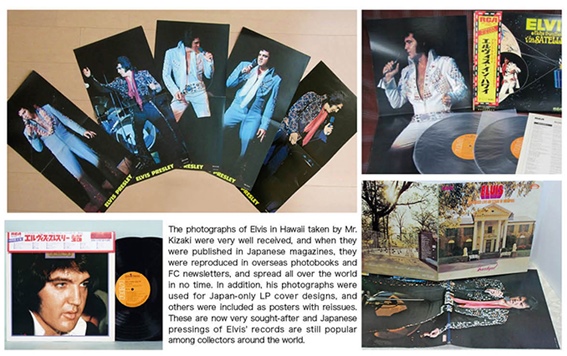 |
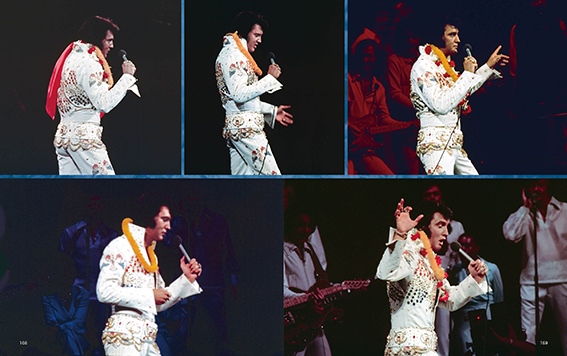 |
(Interview) Dick Dekker and David Ward, authors of the new book, ‘From Memphis To Tokyo – A Reference Guide To The Absolute Mastery of Elvis’ Japanese Vinyl’: With the release of this book imminent, EIN’s Nigel Patterson and Elvis Day By Day’s Kees Mouwen, went treasure hunting in the land of the rising sun to discover what gems can be found in Dick Dekker and David Ward’s new discography about Elvis’ Japanese vinyl (and learning a few new Japanese words in the process).
Discover the delight of Japanese Elvis vinyl...
... The authors discuss the love the Japanese producers put into their releases. Making alternate, high quality and adoring covers for their records, that fascinate Elvis vinyl collectors.
... Virtually every record has something about it that’s different to the equivalent release in another country, whether it be different artwork, different songs or extras like a lyric sheet. That’s what makes the Japanese releases interesting objects for both Elvis and vinyl collectors...
Read Dick and David’s fascinating interview
(Interview, Source: EIN/EDBD)
|
 |
Book Review 'From Elvis in Japan': David Ward's 'From Elvis in Japan: Elvis Presley Japanese LPs 1956-2018' is the a very detailed and visually attractive Elvis “discography”. It covers Elvis LP (vinyl) releases in Japan between 1956 and 2018, the e-book is full of interesting information about each release and stunning images of the LP covers and discs.
The discography contains information on 131 Elvis LPs released in the “land of the rising sun”, a complete song index, and “value add” sections such as How to Read Elvis’ Name in Japanese, Japanese Albums with US Artwork, and English Lyrics (the translations are often outrageously funny!).
Japan also pressed plenty of unique compilations such as 'Elvis Presley Special 24', 'Elvis on Screen', 'Elvis Presley The Complete Singles (11 LP box set)' and 'Elvis Presley By Request of Japanese Fans'.
Go here and discover even more as EIN's Nigel Patterson reviews this fascinating look at Elvis' Japan releases.
(Book Review, Source:ElvisInformationNetwork) |
 |
(Interview) David Ward, author of 'From Elvis in Japan: Elvis Presley Japanese LPs 1956-2018': A new e-book by David Ward chronicles more than 100 Japanese Elvis LPs in great narrative detail and full color images.
Long-time collectors will be very aware of how different many Japanese Elvis records were.
In a fascinating and entertaining interview with EIN’s Nigel Patterson, David discusses:
- the extra effort RCA Japan put into Elvis’ LP releases
rare albums
- what you can find in Japanese obi strips on Elvis LPs
- the Elvis LP obi strip doubling as a poster
- Elvis’ record sales in Japan
- the single you need to hold up to the light
- some very funny Japanese transcriptions of English lyrics, and a lot more.
There is also a shout out to Ernst Jorgensen!
Read David’s full interview - & check out the great covers..
(Interview, Source:ElvisInformationNetwork) |
 |




















